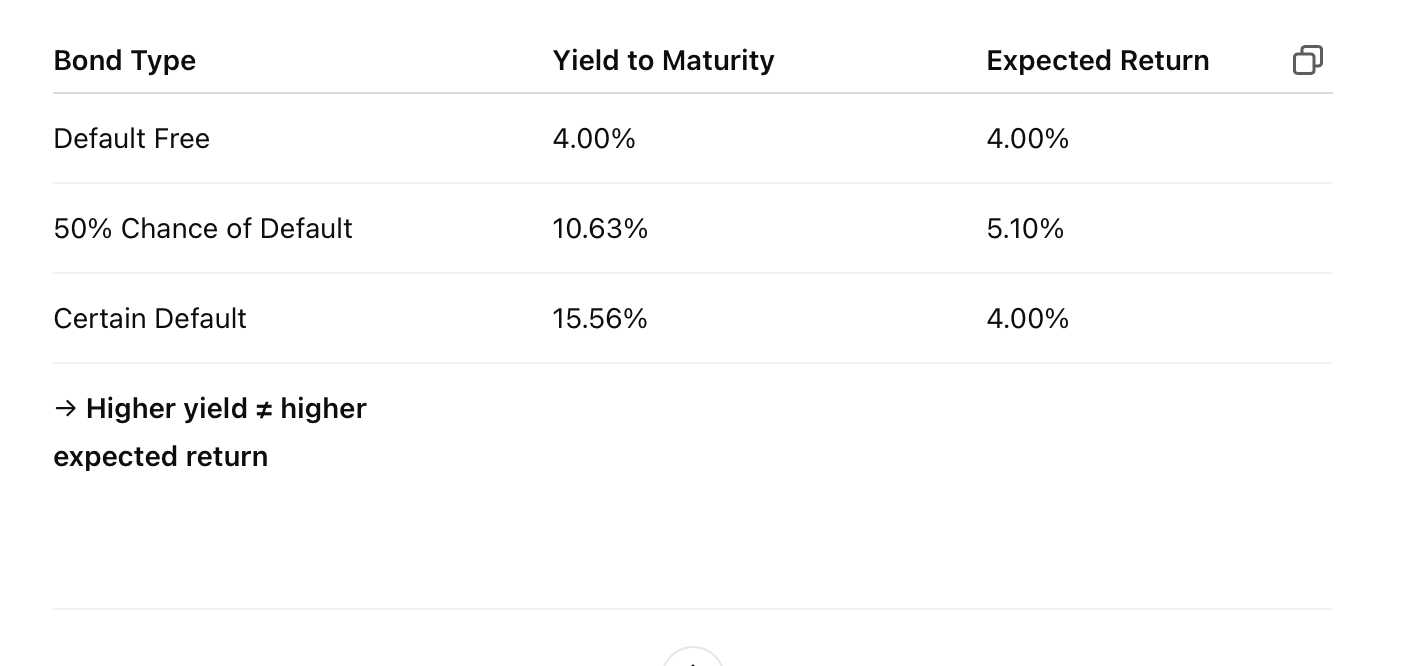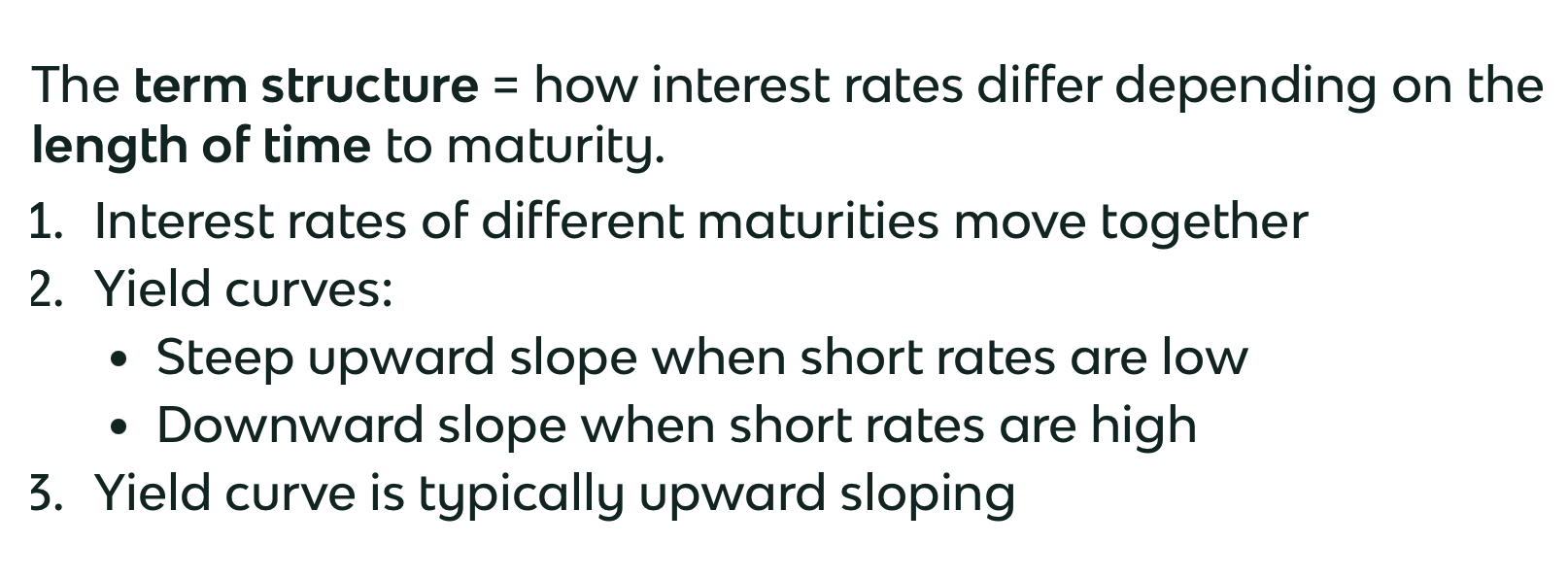IFM - chapter 5 - How do risk and term structure affect interest rates?
1/35
There's no tags or description
Looks like no tags are added yet.
Name | Mastery | Learn | Test | Matching | Spaced |
|---|
No study sessions yet.
36 Terms
What is default risk?
Default risk occurs when a bond issuer is unable or unwilling to:
make interest payments as promised, or
pay off the face value at maturity.
What are default-free bonds?
Bonds (e.g., U.S. Treasury bonds) considered free of default risk because the government can raise taxes or print money to meet obligations.
Are all government bonds default-free?
No. While generally low-risk, government bonds are not entirely free from default. Risk depends on creditworthiness, economic stability, and politics.
Which bonds have low default risk?
U.S. Treasury Bonds: seen as “risk-free” due to strong credit and printing power.
Highly Rated Countries: e.g., Germany, UK, Japan – low-risk but not completely default-free.
Which bonds have high default risk?
Emerging Markets: e.g., Argentina, Venezuela
Recent Defaulters: e.g., Greece during Eurozone crisis
→ Due to economic instability and weaker credit ratings.
What is the credit spread?
The difference in interest rates between bonds with default risk and default-free bonds.
→ Reflects the risk premium investors require. (How much extra return investors demand to compensate for credit risk)
A credit spread is the difference between the yield of a risky bond and a risk-free bond of the same maturity.
How does credit spread relate to default risk?
Bonds with default risk always have a positive risk premium.
If default risk ↑ → risk premium ↑
Why do investors care about default probability?
It influences the size of the risk premium and helps assess risk. Investors use credit-rating agencies (e.g., Moody’s, S&P, Fitch) for estimates.
What are bond ratings and what do they mean?
Ratings like AAA (Moody’s, S&P, Fitch) indicate lowest risk. Ratings go down to C, indicating high or certain risk of default.
What are corporate bonds and their risk?
Issued by corporations
Subject to credit/default risk
→ Their cash flows are not certain.
How do corporate bond yields relate to credit risk?
Investors pay less for bonds with credit risk ⇒ Yield is higher than that of identical default-free bonds.
A corporate bond’s yield (the return investors demand) reflects how risky the bond is.
Why is the yield to maturity of a bond with certain default misleading?
Because it overstates the actual return; expected return is lower due to the certainty of not receiving full payments.
What does a higher yield to maturity imply if there is default risk?
It does not guarantee a higher expected return. A bond’s expected return is less than its yield if default is possible.
In the Avant Bond example, how do yield and return compare across different default risks?

What is a liquid asset?
An asset that can be quickly and cheaply converted to cash. More liquid = more desirable.
What is the risk premium in bond pricing?
The difference between corporate and Treasury bond interest rates:
Reflects default risk and liquidity
More accurately: risk and liquidity premium
👉 Bonds with higher risk (corporate bonds, junk bonds, emerging market bonds...) must offer investors a higher yieldthan a risk-free bond (like a government bond) to attract buyers.
👉 This extra yield = risk premium.
Why do US municipal bonds have lower rates than Treasuries despite higher risk?
Because US municipal bonds are exempt from federal income tax, while:
Treasury bonds are exempt from state & local income tax
Corporate bonds are fully taxable
But municipal bonds are NOT default-free and NOT as liquid as Treasuries.
How does maturity affect interest rates?
Bonds with different maturities have different required interest rates — longer maturities typically demand higher yields, all else equal
what three facts must a good theory of the term structure of interest rates explain?
The term structure = how interest rates differ depending on the length of time to maturity.
Interest rates of different maturities move together
Yield curves:
Steep upward slope when short rates are low
Downward slope when short rates are high
Yield curve is typically upward sloping
short rate: The interest rate on a short-term loan or a short-term bond.
What are the three theories of term structure and what do they each explain?
Expectations Theory: explains (1) and (2)
Market Segmentation Theory: explains (3)
Liquidity Premium Theory: explains all three by combining the above two

What is the key assumption and implication of the Expectations Theory?
Assumption: Bonds of different maturities are perfect substitutes
Implication: Expected returns on all maturities are equal
What does the Expectations Theory say about investment strategies over 2 years?
Strategy 1: Buy 1-year bond twice
Strategy 2: Buy 2-year bond once
→ If the theory is correct, both yield the same expected wealth
(But actual wealth may differ if rates change)
How does the Expectations Theory explain different yield curve shapes?
Short rates ↑ in future → upward slope
Short rates stay the same → flat curve
Short rates ↓ in future → downward slope
How does Expectations Theory explain that short and long rates move together?
If short rate ↑ today, expected future short rates ↑ too
→ Average of future rates ↑ → long-term interest rates ↑
Why do yield curves steepen when short rates are low?
If short rates are low, they’re expected to rise
→ Future rates > current → steep upward-sloping curve
The yield curve steepens when short rates are low because markets expect them to rise in the future, and investors demand extra compensation for holding long-term bonds.
Why doesn’t Expectations Theory explain why yield curves are usually upward sloping?
Because short rates are equally likely to rise or fall
→ Future average rates won’t consistently be higher
→ So theory can’t explain the usual upward slope
What is the key assumption and implication of Market Segmentation Theory?
Assumption: Bonds of different maturities are not substitutes at all
Implication:
Markets are completely segmented
Interest rates at each maturity are determined independently
SUPPLY AND DEMAND
What does Market Segmentation Theory explain about the yield curve?
✔ Explains Fact 3: yield curve is usually upward sloping
People prefer short holding periods → higher demand for short-term bonds
Short-term bonds: higher price, lower interest rates
✘ Does not explain Facts 1 and 2 (rates determined independently)
What is the key assumption and implication of Liquidity Premium Theory?
Assumption: Bonds of different maturities are substitutes, but not perfect substitutes
Implication: Combines expectations theory with market segmentation theory → explains all 3 facts
Why do investors require a liquidity premium for long-term bonds?

Why does the Liquidity Premium Theory explain all three facts of the term structure?
Explains Fact 3: yield curve is usually upward sloped because of the liquidity premium for long-term bonds
Explains Fact 1 & 2: like the expectations theory, it uses the average of future short rates to determine long-term rates
How is the term structure of interest rates useful as a forecasting tool?
The yield curve provides information about future interest rates
It helps forecast inflation and real output
Rising rates → economic booms
Falling rates → recessions
Rates include both real and expected inflation components
Why are interest-rate forecasts important for financial institutions?
Future changes in interest rates affect profitability
Managers must set loan interest rates in advance for future periods
→ Accurate forecasts are crucial for planning and pricing
What does the slope of the yield curve tell us about future interest rates?
A steeply upward-sloping yield curve → future rates expected to rise
A downward-sloping yield curve → future rates expected to fall
→ Reflects the market's prediction of interest rate direction
What is the difference between forward and spot rates?

What is a forward interest rate, and how is it used?
A forward rate is the interest rate agreed today for a loan or investment that will happen in the future.
A forward rate is guaranteed today for a future loan or investment
Example: Forward rate for year 5 is the rate for a 1-year investment starting 4 years from now